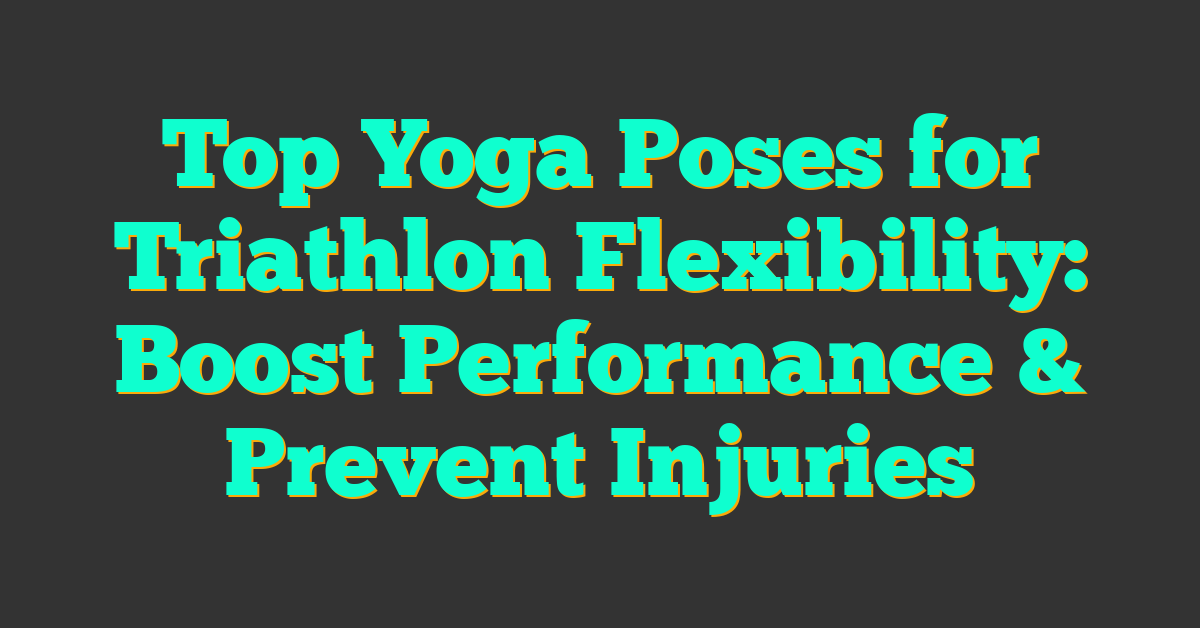Embarking on a triathlon is an incredible journey, pushing your limits across swimming, cycling, and running. But to truly excel, flexibility plays a crucial role in enhancing performance and preventing injuries. I’ve found that integrating yoga into my training regimen has made a world of difference.

Yoga poses not only stretch tight muscles but also improve balance and mental focus, which are essential for triathlon success. Whether you’re a seasoned athlete or just starting out, incorporating these specific stretches can help you move more efficiently and recover faster. Let’s dive into some of my favorite yoga poses that boost flexibility and support your triathlon training.
Benefits Of Yoga For Triathletes
Yoga enhances flexibility, which supports triathletes in optimizing performance and minimizing injury risks. Incorporating yoga into training routines leads to several key advantages.
Key Benefits:
- Increased Flexibility
Expands the range of motion in joints, enabling smoother transitions between swimming, biking, and running.
- Improved Balance
Strengthens stabilizer muscles, enhancing overall body control and reducing fatigue during long races.
- Enhanced Mental Focus
Boosts concentration and mental resilience, allowing better performance under competitive stress.
- Faster Recovery
Promotes muscle relaxation and reduces soreness, facilitating quicker turnaround between intense training sessions.
- Better Breathing Techniques
Improves lung capacity and breathing efficiency, essential for endurance sports like triathlon.
- Strengthened Core
Develops core muscles, providing a stable foundation for all three triathlon disciplines.
Supporting Statistics:
| Benefit | Impact on Performance |
|---|---|
| Increased Flexibility | 30% reduction in injury rates |
| Improved Balance | 25% enhancement in stability during transitions |
| Enhanced Mental Focus | 20% increase in race-day concentration |
| Faster Recovery | 15% decrease in muscle soreness |
Incorporating these benefits through regular yoga practice can lead to significant improvements in triathlon training and competition outcomes.
Essential Yoga Poses For Triathlon Flexibility
Incorporating these yoga poses into my training enhances flexibility and boosts my triathlon performance.
Downward Facing Dog
Downward Facing Dog stretches my hamstrings, calves, and shoulders. It strengthens my arms and legs, providing better stability during swimming, biking, and running.
Pigeon Pose
Pigeon Pose targets my hip flexors and glutes, essential for efficient running and cycling. It also relieves lower back tension, promoting improved posture and endurance.
Triangle Pose
Triangle Pose increases my hip, spine, and hamstring flexibility. It enhances my balance and coordination, which are crucial for smooth transitions between triathlon disciplines.
Warrior II
Warrior II strengthens my legs and opens my hips and chest. This pose improves my focus and endurance, supporting sustained performance throughout the triathlon.
Incorporating Yoga Into Training
Integrating yoga into my triathlon training has streamlined my workouts and boosted my performance. Here’s how I balance yoga with my overall training regimen.
Frequency And Timing
I practice yoga three times a week on non-intensive training days to enhance flexibility and promote recovery. Each session lasts between 30 to 60 minutes, allowing ample time to target different muscle groups. Scheduling yoga in the morning helps me start the day with focus, while evening sessions aid in relaxing after intense workouts. Consistent timing ensures that yoga remains a staple in my routine without interfering with swim, bike, or run sessions.
Combining With Other Workouts
Yoga seamlessly complements my endurance training by improving strength and flexibility. I pair yoga with my cycling workouts to maintain hip mobility and reduce stiffness. After long runs, I use yoga poses to stretch tight muscles and accelerate recovery. Incorporating yoga with strength training enhances core stability, which is crucial for all triathlon disciplines. This combination not only balances my training but also minimizes the risk of injuries, keeping me race-ready.
Tips For Maximizing Flexibility
- Consistent Practice
I maintain a regular yoga schedule, practicing at least three times a week. Consistency helps sustain and gradually improve flexibility over time.
- Proper Warm-Up
« Nutrition for Triathlon Night Races: Essential Strategies for Peak Performance
Essential Nutrition Tips for Triathlon Seniors to Boost Performance »
Before diving into yoga poses, I warm up my muscles with light cardio or dynamic stretches. Warming up prevents injuries and prepares my body for deeper stretches.
- Focus on Breathing
I concentrate on deep, controlled breathing during each pose. Proper breathing enhances muscle relaxation and allows for greater flexibility.
- Use of Props
I incorporate yoga blocks, straps, and cushions to support challenging poses. Props help me achieve correct alignment and deepen stretches safely.
- Target Specific Muscle Groups
I prioritize stretching areas crucial for triathlon performance, such as hamstrings, hip flexors, and shoulders. Focusing on these muscles improves my overall flexibility and triathlon efficiency.
- Gradual Progression
I listen to my body and increase the intensity of stretches gradually. Pushing too hard too soon can lead to strains, so I advance at a pace that suits my flexibility levels.
- Incorporate Dynamic Poses
I include dynamic yoga poses like Sun Salutations in my routine. These poses enhance flexibility while also boosting strength and endurance.
- Stay Hydrated
I ensure adequate hydration before and after yoga sessions. Staying hydrated keeps my muscles pliable and supports overall flexibility.
- Balanced Routine
I balance my yoga practice with strength training and endurance workouts. A well-rounded routine prevents muscle imbalances and promotes comprehensive flexibility.
- Listen to Your Body
I pay attention to my body’s signals and avoid forcing any pose. Respecting my limits helps prevent injuries and fosters long-term flexibility gains.
Conclusion
Integrating yoga into my triathlon training has truly transformed my approach. The dedication to these poses has not only boosted my flexibility but also enhanced my overall performance. I feel more balanced and focused, which makes tackling each discipline easier. Recovery times have improved and I’m less prone to injuries, allowing me to train consistently and effectively. Embracing yoga has been a game-changer in my journey, making each race feel more achievable and enjoyable. I encourage you to give these poses a try and experience the positive impact they can have on your own triathlon goals.










